PYREX GLASS
Some Basic History / Information
Corning Glass Company/Corning Glass Works, Corning, New York (1875-to present), now known as Corning Incorporated
The trademark “Pyrex” was introduced in 1915 for Corning Glass Works’ borosilicate heat-resistant glassware formula. This glass had been developed in 1908 under the name “NONEX” and was used, at first, mostly for railroad lantern globes and electrical battery jars.
Bessie Littleton, the wife of Corning engineer Jessie Littleton, asked her husband to bring home some samples of that type of glass for her to try baking with, and when baking a cake she found that the new borosilicate glass stood up to heating in an oven without breaking. This led to the creation of the “PYREX” brand name.
The brand name “PYREX” is a contraction of “Pie” and “Nonex”. This stronger, more durable glass was first used with pie plates and kitchen-related glass subjected to high temperatures.
VERY large quantities of durable glass products such as kitchenware, ovenware, cookware, measuring cups and pitchers, as well as technical, scientific and laboratory glassware have been made for well over a century. Also, large quantities of industrial glass such as glass electrical insulators for telephone and power lines were made over many years.
Pyrex glass cookware has been a staple in American households for many decades. Some of their items include: square and rectangular baking dishes/pans (for cakes, casseroles, homemade bread, baked puddings, etc) of various sizes and designs. Also very popular have been other items such as oval and round casserole dishes, refrigerator dishes, mixing bowls, butter dishes, loaf pans, cake dishes, au gratin dishes, pie plates, serving bowls, measuring cups, teapots, rolling pins, utility dishes, custard cups, nursing bottles, reamers, roasters, carafes, coffee makers, saucepans, storage containers, and other items.
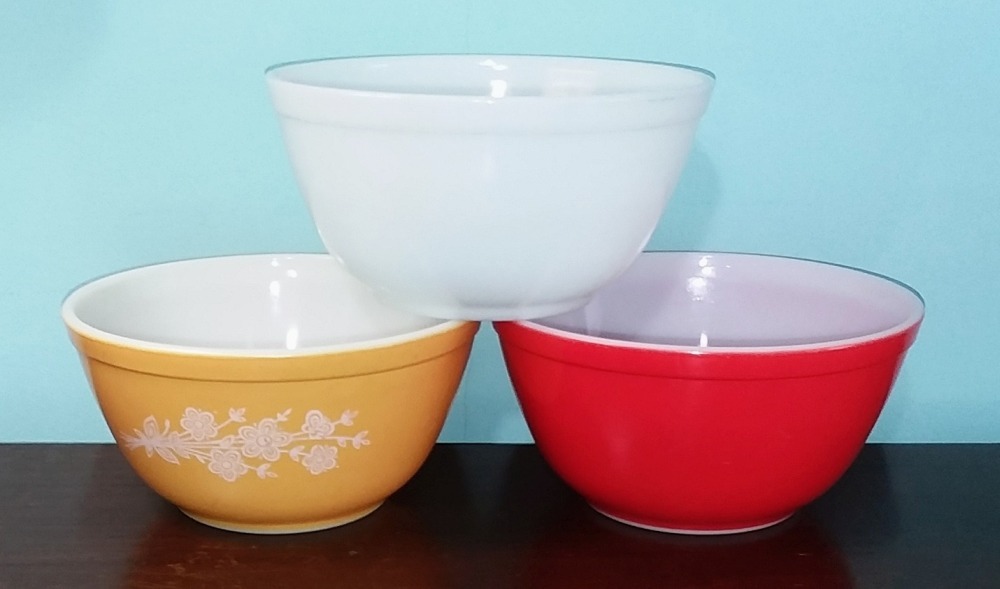
Pictured here are examples of vintage PYREX name brand ovenware casserole / mixing bowls. The style or inventory number assigned to this size/type of bowl appears to be “402” as each example has that number embossed on the base, as well as the lettering “TRADE MARK / PYREX / R [in circle] / MADE IN U.S.A. / OVEN WARE”.
Each measures about 7 & 1/4th inches in diameter and 3 & 3/4ths inches in height. They are made of white translucent milk glass with colored “flashing” on the outside surface. They probably date from the 1960s – 1980s.
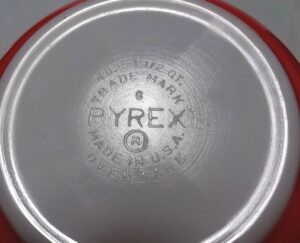
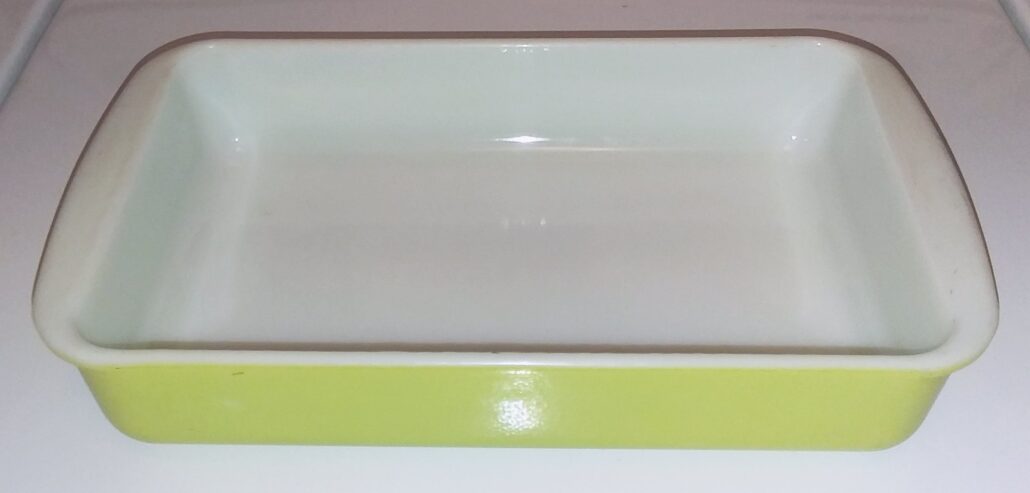
ADVERTISEMENT
A variety of bottles, jars and other types of heat and chemical-resistant laboratory glassware products are also found with the “PYREX” name embossed on the bottom. Glass tubing, test tubes, lab chemical bottles, funnels, beakers, serum vials and other miscellaneous laboratory equipment and containers were made in large quantities.


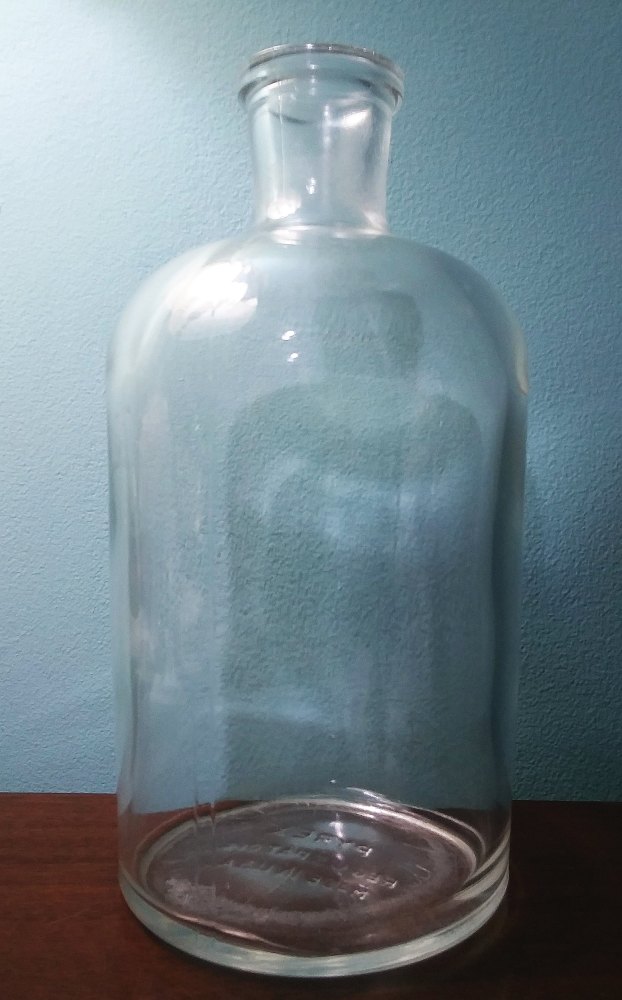
Just a fun note — some of the glassware you might see in a “mad scientist” laboratory scene in old movies are very likely products of Corning!
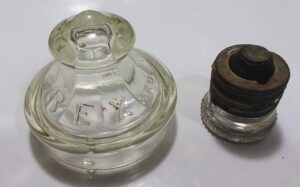
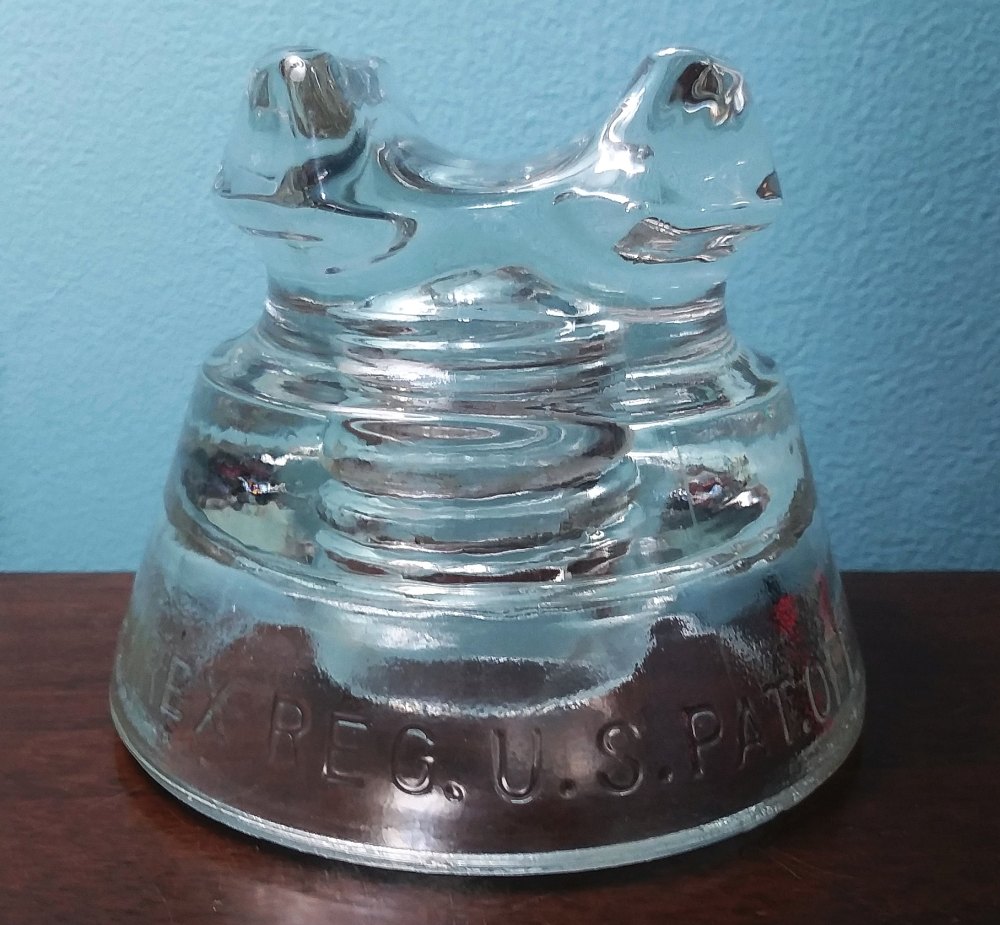
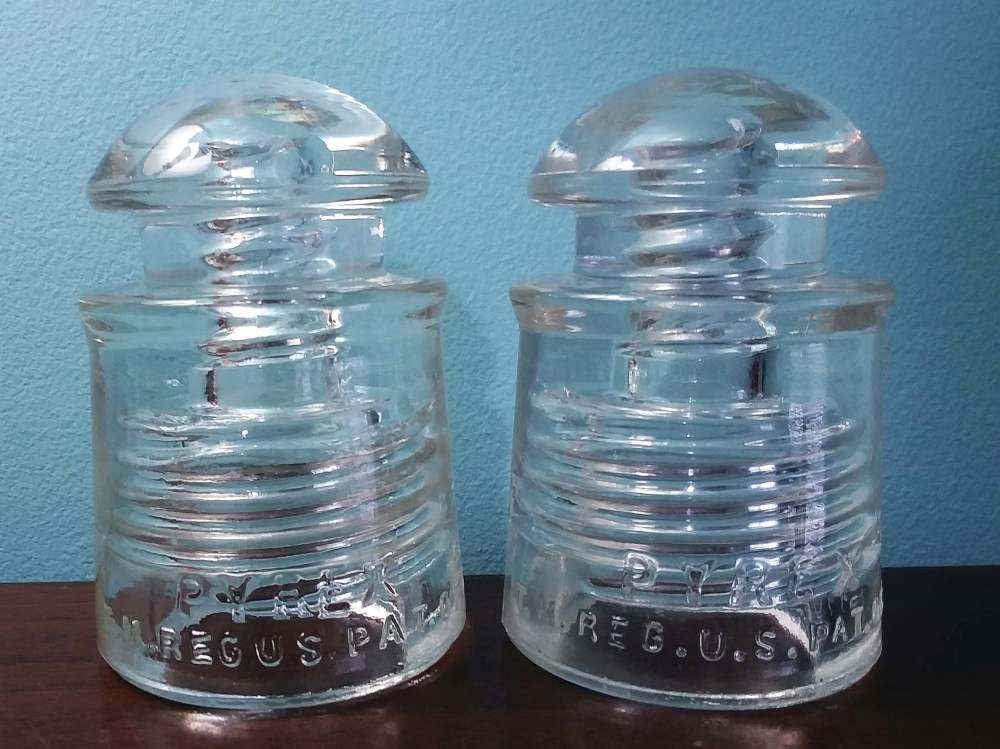
Pyrex Glass Insulators
Huge numbers of glass electrical insulators were made by Corning with the “PYREX” brand name embossed on them. The great majority of them are found in clear glass. Some insulators were made in “Carnival Glass” (glass made with an iridized surface coating of mineral salts) , bearing the PYREX / CORNING brand marking.
The most common Pyrex glass insulator (found in clear) would probably be the CD 128 style (shown in photo above). A search of the internet, such as Google Images pages with “Pyrex glass insulator” and “CD 128” would bring up more examples of that particular shape. There are more than 25 different styles of PYREX pin-type insulators known, plus others such as radio strain types.
According to information in this web article by collector and researcher Greg Hafer, all Pyrex insulators were made between 1923 and 1945.
PYREX INSULATORS – Greg Hafer Article
NOTE: In 1998, Corning discontinued the production of their PYREX line of glassware, (concentrating instead on their lines of industrial and tech-related products) and the rights to the PYREX brand name were assigned to World Kitchen, LLC (under that name 2000 to 2018, later known as Corelle Brands, now [2023] known as Instant Brands). Their website is located at: https://www.corelle.com/about-us . More information on current products can be found at that site. (UPDATE: Instant Brands has apparently filed for bankruptcy as of June of 2023).
The original formula for the glass produced for the United States market was evidently changed, after 1998, to a tempered soda-lime glass. There have been complaints by consumers that this recently-made glassware (ovenware, etc) has sometimes shattered, and appears to be inferior to previous standards of durability characteristic of the earlier borosilicate formula.
CORNINGWARE
Corning Glass Works merged with Macbeth-Evans Glass Company (its factory located in Charleroi, Pennsylvania since 1893) in 1936. By the mid-1940s, the Corning Glass Works – Macbeth-Evans Division was selling durable opaque PYREX cookware, eventually known as “CorningWare” (that brand name was introduced circa 1958) and later the “Corelle” brand which was introduced in 1970. Much of that CorningWare / Corelle glassware has been manufactured at the Charleroi, PA plant over many decades. https://blog.cmog.org/2015/pyrex-40s
After several confusing company ownership changes, the Charleroi plant was purchased by Anchor Hocking (its main plant in Lancaster, Ohio) in March of 2023. In September of 2024, announcements were made that the Charleroi plant would close down, and production of Corning Ware glass would be shifted to Anchor Hocking’s main glass plant in Lancaster. Some information on the Charleroi glass plant closing is here in this newspaper article:
Charleroi PA glass plant to close
For a well-written and researched article with details on their change from borosilicate glass to a soda-lime glass formula in recent decades, see this page:
The PYREX Glass Controversy That Just Won’t die
Some basic information (with questions and answers concerning Pyrex glassware) can be found on this webpage which is part of the Corning Museum of Glass website: https://pyrex.cmog.org/faq
Collecting Vintage Pyrex (From the “Adirondack girl at heart” website):
https://adirondackgirlatheart.com/collecting-vintage-pyrex/
Brief History of Pyrex:
https://www.foodandwine.com/lifestyle/kitchen/history-of-pyrex
Corning Museum of Glass article: “A Century of Pyrex”:
https://www.cmog.org/article/pyrex
A Brief History of Pyrex Kitchenware
https://www.pyrexcollector.com/history.php
Marta Stewart’s site article about collecting vintage Pyrex:
https://www.marthastewart.com/7692706/collecting-vintage-pyrex
Article from the Federal Trade Commission on the controversy about some PYREX products having been made in China, despite claims that all are made in the USA.
https://www.ftc.gov/business-guidance/blog/2023/01/ftc-reminds-company-makes-pyrex-glassware-be-transparent-about-made-usa-claims
ADVERTISEMENT
Here is a keyword search of current Pyrex glass items for sale on the eBay auction site:
A beautifully illustrated reference book that I would recommend for any and all Pyrex glass collectors would be: “PYREX – The Unauthorized Collector’s Guide“, by glass researcher and author BARBARA MAUZY. This book was first published in 2000, by Schiffer Publishing, Ltd. The book has been revised several times and there are at least 5 editions now in print, the last (I believe) having been released in 2014. The books are profusely illustrated with hundreds of full-color photos of Pyrex products of every description. The 5TH edition has 192 pages. I would suggest a search of bookfinder.com for that as well as older editions that might be available!
“PYREX” MARKED INSULATORS ON EBAY
PYREX glass insulators on Ebay
For more detailed background info on this glass, check out the Wikipedia entry about Pyrex Glass: PYREX insulators – Wikipedia
For an extensive alphabetical list of glass manufacturers’ marks seen on bottles, fruit jars, insulators, tableware and other glassware, please click here to go to the Glass Bottle Marks pages
Please click here to go to my “Glass Bottle Marks” website Home Page.
ADVERTISEMENT


As an amateur astronomer, I would mention that tons of Pyrex glass has been made into reflecting telescope mirrors over the years. I have 10″, a 15″, and 20″ mirrors in Dobsonian
telescopes. Most are 2″ thick and weigh up to 60 lbs. They make good telescope mirrors because of their low expansion and contraction with temperature, so that their ground figure does not distort. I believe that Corning still makes the glass available for this purpose.
Thank you Joseph! Good information!
~David
Soda lime glass has 1/3 the temperature differential of borosilicate glass, if both are perfectly annealed.
Soda lime glass has a temperature differential of 99 °F, yes only 99 degrees!!! Pouring very HOT near boiling drippings into the new soda lime Pyrex measuring cups can crack/shatter them.
Borosilicate glass has a temperature differential of 330 °F,
Pyrex oven dishes are made from this glass, and I hope they are still are. If that $30+ dish of organic lasagna, breaks, the manufacturer is going to get such bad reviews, that out-of-business looms on their failed 5-year plan.
Unfortunately, Pyrex is NOT made from borosilicate glass and has not been for almost 20 years. If an item has a stamp or printed logo in all capital letters, it’s a safe bet that it’s borosilicate. Newer items have the name/logo in all lower case letters, and these are made from soda lime glass.
Why does the print come off the measuring cups so fast now? I had them for years before. Now on the new ones I buy the print comes right off the cup Isn’t any good without the measurements. A senior
Annette, if the print comes off quickly, you might have to buy more cups, and the company sells more product!?? Well, just kidding. I don’t know but I assume the ACL (applied color label) techniques being used on the newer measuring cups are different in some ways than the older type….that is, INFERIOR methods for producing a lasting image. …..it seems the best ACL graphics were during the 1940s-1960s (such as used on soda bottles, milk bottles, glass sugar and flour canisters, etc). Or maybe that is just a faulty observation of my own that doesn’t hold water.
Sorry I have no definitive answer. Perhaps a reader can offer more solid feedback on this subject.
~David
Thank you dear for answering, I always love Pyrex and always used the glass coffee pot for many many years. It just broke and I’m so lost with out it. I wish they were still making them like years ago. I don’t like the new machines they have. Now I love the smell of perk coffee on the stove. Oh well, nothing I can do about that now. Love, a senior.
Hi Annette!! This is what etsy is for 🙂 I sell tons of vintage pyrex and pyrex flameware. I myself, use a pyrex flameware percolator.
Look me up, if I don’t have one listed, I will find you one, and I am happy to walk you though the checkout process.You do not have to be a member of etsy to purchase from etsy.
Carrie
http://www.etsy.com/shop/AKitschIsJustAKitsch
The glass was not tempered correctly. If you contact the company, I bet they’d replace it for you. The glass would have to be tempered at the factory and there is nothing in the environment that could cause this to happen on a piece of glassware that was tempered adequately. Extreme temps will only impact an untempered piece of glass.
Hi Janet,
Yes, proper tempering of glass does REDUCE, but DOES NOT competely ELIMINATE the chance of breakage. There have been hundreds of reports in recent years of this cookware shattering. Such things have happened over the years occasionally, but the frequency of the occurrences have greatly increased after the manufacturers changed their formula to a cheaper grade of glass. SO, whether or not the glass was properly tempered, it is a less durable grade of glass, not as strong and resistant to breakage as the original Pyrex formula was.
The problem seems to be that the more recently-made Pyrex glass (distributed by World Kitchen) and it’s main competitor brand of cookware (manufactured by Anchor Hocking) are now made of a soda-lime glass instead of BOROSILICATE glass which was the original PYREX formula and which much more resistant to sudden temperature changes.
From Consumer Reports, quote: “U.S. manufacturers of both Pyrex and Anchor Hocking have switched from borosilicate to soda lime glass for their glass bakeware”
Please check out this webpage:
https://www.techfragments.com/exploding-pyrex-cookware/
Take care, David
I had a Pyrex 4 cup measuring cup explode in my cupboard.I have had it for only about 8 months. What would have caused this?
I don’t know, but assume it is a more recent, perhaps poorly annealed / lower quality glass. Even Pyrex can break if subjected to sudden EXTREMES of heat and cold within a short period of time.
David